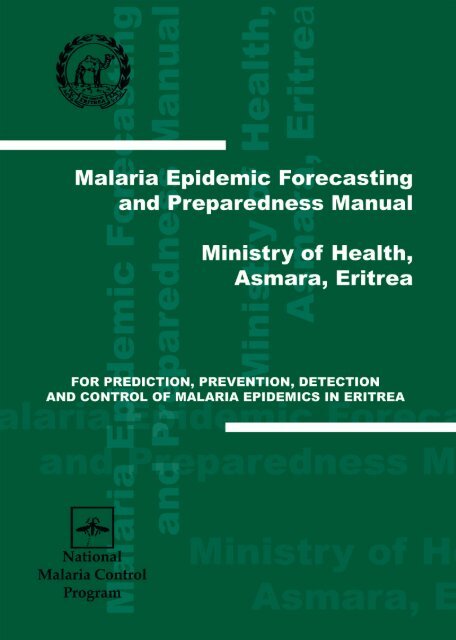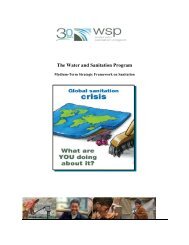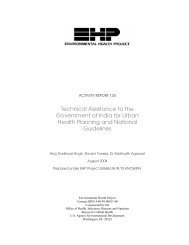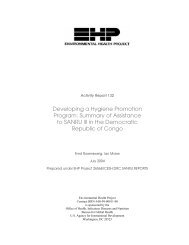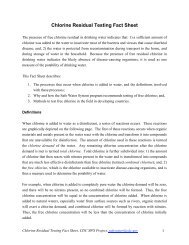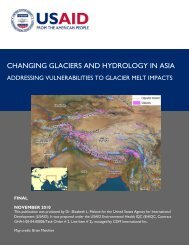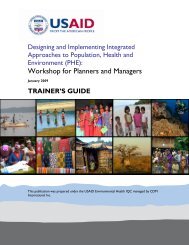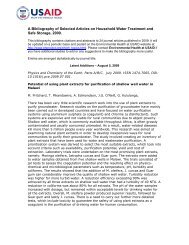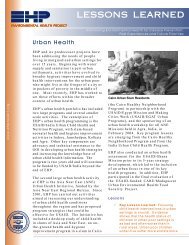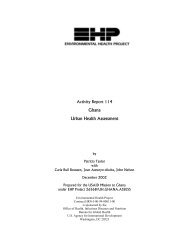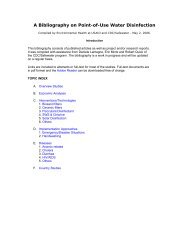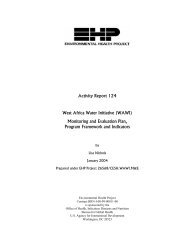Malaria Epidemic Forecasting and Preparedness Manual
Malaria Epidemic Forecasting and Preparedness Manual
Malaria Epidemic Forecasting and Preparedness Manual
You also want an ePaper? Increase the reach of your titles
YUMPU automatically turns print PDFs into web optimized ePapers that Google loves.
<strong>Malaria</strong> <strong>Epidemic</strong> <strong>Forecasting</strong><strong>and</strong> <strong>Preparedness</strong> <strong>Manual</strong>Ministry of Health, Asmara, EritreaFor Prediction, Prevention, Detection <strong>and</strong> Controlof <strong>Malaria</strong> <strong>Epidemic</strong>s in EritreaJune 2003Produced with support fromthe World Bank HAMSET project<strong>and</strong> USAID/Environmental Health Project for Eritreaby Patricia M Graves
Prepared by EHP for the National <strong>Malaria</strong> Control ProgramCommunicable Disease Control DivisionMinistry of Health, Asmara, EritreaEnvironmental Health ProjectContract HRN-I-00-99-00011-00is sponsored by theOffice of Health, Infectious Diseases <strong>and</strong> NutritionBureau for Global HealthU.S. Agency for International DevelopmentWashington, DC 20523
ContentsIntroduction................................................................................. i1.General Definition of an <strong>Epidemic</strong> ..........................................12.Characteristics of <strong>Malaria</strong> <strong>Epidemic</strong>s in Eritrea.......................33.Geographic Stratification .........................................................74.Assessing Vulnerability ...........................................................95.<strong>Epidemic</strong> <strong>Forecasting</strong> <strong>and</strong> Warning .......................................116.<strong>Epidemic</strong> Detection................................................................177.<strong>Epidemic</strong> <strong>Preparedness</strong> ..........................................................278.<strong>Epidemic</strong> Response................................................................29Eritrea <strong>Epidemic</strong> <strong>Manual</strong>, June 2003i
IntroductionThis manual is written for zoba malaria coordinators (<strong>and</strong> futuresub-zoba malaria coordinators) to help predict, prevent, detect<strong>and</strong> control malaria epidemics in Eritrea.<strong>Epidemic</strong> preparedness <strong>and</strong> prevention is mostly a matter ofbeing on alert. From year to year, the probability of an epidemicvaries depending on biological factors, social factors, <strong>and</strong>particularly the weather. The level of alert varies from year toyear depending on these factors. In this manual, we will usethree levels of alert in a colour-coded system:REDYELLOWGREENWe can think of these levels as a series of steps, raising alertfrom the baseline (Green) to higher levels (Yellow <strong>and</strong> Red). Inthe manual, we define which factors should cause the alert levelto rise up a step. These are noted in “boxes” in the text, <strong>and</strong>summarised on Page 22.Eritrea <strong>Epidemic</strong> <strong>Manual</strong>, June 2003iii
There are also criteria for deciding when to move down a step inthe alert level. This is an important part of the system becauseotherwise you would be permanently on high alert.The alert level should ideally be decided by the sub-zoba. Thisis because the likelihood of epidemics varies too much over azoba or over the country as a whole. Since the alert leveldepends greatly on the amount of recent local rainfall, it cannotbe decided unless there is a source of rainfall data for the subzoba.The manual is organized as follows:In Sections 1 <strong>and</strong> 2, we provide a general definition of anepidemic <strong>and</strong> describe key characteristics of malaria epidemicsin Eritrea.In Eritrea there is large variation in malaria incidence across thecountry due to altitude, terrain, amount of rainfall <strong>and</strong> proximityto water. In Section 3, we describe this variation in terms of“geographical stratification.” This does not vary much from yearto year. We can then add information on factors which dochange from year to year as discussed under “AssessingVulnerability” in Section 4. We use such information to decideon the likelihood of an epidemic in any particular year. Thislikelihood is characterized by the alert level.Action to prevent or control an epidemic should not wait untilafter an epidemic is in progress. Certain actions can be takenafter forecasting <strong>and</strong> warning indicate that the level of alert ishigh. The appropriate actions to be taken are discussed underSection 5: “<strong>Epidemic</strong> <strong>Forecasting</strong> <strong>and</strong> Warning.”Once an epidemic has been detected, we should move from“ALERT” to “RESPONSE.” How to detect an epidemic isdiscussed in Section 6 “<strong>Epidemic</strong> Detection.” How to preparefor epidemics is discussed in Section 7 “<strong>Epidemic</strong>ivEritrea <strong>Epidemic</strong> <strong>Manual</strong>, June 2003
<strong>Preparedness</strong>,” <strong>and</strong> what actions to take during response aredescribed in Section 8 “<strong>Epidemic</strong> Response.”When an epidemic is over, we move back from “responsemode” to “alert mode.” The criteria for deciding when anepidemic is over are discussed in “Definition of an epidemic” inSection 6.Eritrea <strong>Epidemic</strong> <strong>Manual</strong>, June 2003v
1. General Definitionof an <strong>Epidemic</strong>The usual definition of an epidemic is the following:“The occurrence in a community or region of cases of anillness, clearly in excess of normal expectancy.”This definition shows that we have to define an epidemic withreference to a particular geographic area (community orregion). Also, to know how many cases are expected, we haveto know what time period we are talking about.Thus, for example, we could say that in the whole country(geographic area) in the year 1998 (time period), we had amalaria epidemic. However, this is on a very large scale of area<strong>and</strong> time, <strong>and</strong> is not very informative. If we want to be morespecific, we could also say that in Massawa subzone(geographic area) in the month of January 2001 (time period)we had an epidemic. This is a more medium area <strong>and</strong> time-scale.On an even smaller scale, we could say that in a certain village(geographic area) in the first week of October 2002 (timeperiod) we had an epidemic. For all of these situations, we needto know what number of cases would normally be expected forthat place <strong>and</strong> time period.Often, an increase in cases is called an outbreak. This word issometimes used for an increase in case numbers in a smallgeographic area (e.g., in a village), or for cases that occur in aplace that usually does not have malaria. However, there is noreal difference between the definition of outbreak <strong>and</strong> ofepidemic.Eritrea <strong>Epidemic</strong> <strong>Manual</strong>, June 2003 1
2. Characteristics of<strong>Malaria</strong> <strong>Epidemic</strong>sin EritreaIn Eritrea, there is also a lot of variation in transmission fromplace to place in the country. In some parts, for example thesouthwest, there is transmission year-round, but the number ofcases is usually much higher in some months than other. Inthese places, the seasonal rise in transmission is expected everyyear. In other places, such as on the Red Sea coast, there is a risein malaria cases in some years, but not every year.Therefore there are two distinct types of malaria epidemicswhich occur:• The seasonal increase in malaria transmission is muchgreater than expected.• Increased malaria transmission occurs in a place thatusually has very low numbers of cases.An example of the first type of epidemic is given in Fig. 1.Eritrea <strong>Epidemic</strong> <strong>Manual</strong>, June 2003 3
Fig 1: GASH BARKA - GULUJ 1996 - 2001malaria outpatient cases40003500<strong>Malaria</strong> OPD cases300025002000150010005000Jan- Apr- Jul- Oct- Jan- Apr- Jul- Oct- Jan- Apr- Jul- Oct- Jan- Apr- Jul- Oct- Jan- Apr- Jul- Oct- Jan- Apr- Jul- Oct- Jan-96 96 96 96 97 97 97 97 98 98 98 98 99 99 99 99 00 00 00 00 01 01 01 01 020Jan- Apr- Jul- Oct- Jan- Apr- Jul- Oct- Jan- Apr- Jul- Oct- Jan- Apr- Jul- Oct- Jan- Apr- Jul- Oct- Jan- Apr- Jul- Oct- Jan-96 96 96 96 97 97 97 97 98 98 98 98 99 99 99 99 00 00 00 00 01 01 01 01 02MonthFig. 1 shows the number of cases by month from Guluj healthcentre from January 1996 to December 2001. There is a peak oftransmission every year, around September or October.However in 1998, the peak was much higher than usual <strong>and</strong> wasclearly higher than expected. Thus we can say that in this healthcentre, during October 1998, there was a malaria epidemic.An example of the second type of epidemic is shown in Fig. 2.Fig 2: NORTHERN RED SEA - MASSAWA 1996 - 2001malaria opd2500<strong>Malaria</strong> OPD Cases200015001000500Month4Eritrea <strong>Epidemic</strong> <strong>Manual</strong>, June 2003
As you see in Fig. 2, in Massawa subzoba, there is not a regularseasonal peak of transmission. Instead, there is low leveltransmission most of the time, with occasional peaks. In thiscase it seems that there were epidemics in January 1998 <strong>and</strong>January 2001.To underst<strong>and</strong> the likelihood of epidemics in a particular area ata particular time, we need to have knowledge of the past historyof cases in that particular area so that we know how many casesare expected. Much of that information is known by theexperienced staff, but it is important to document it to make itclear <strong>and</strong> to pass on the knowledge to others.We also need to give a figure of the number of epidemics thatoccurred in particular areas over particular time periods (forexample, by year or quarter). This is because one of the targetsof the NMCP is to reduce the number of malaria epidemics <strong>and</strong>the number of cases during epidemics. This cannot be evaluatedunless we know how many epidemics were occurring in the past<strong>and</strong> present, <strong>and</strong> how many may occur in the future.Eritrea <strong>Epidemic</strong> <strong>Manual</strong>, June 2003 5
3. GeographicStratificationStratification is used to define the underlying probability ofmalaria infection in a particular place. It can be thought of as thelevel of endemicity. This depends on altitude, proximity torivers <strong>and</strong> water bodies, <strong>and</strong> usual rainfall, <strong>and</strong> is fairly constantfrom year to year.The tremendously varied distribution of malaria in the country iswell known, <strong>and</strong> most zoba coordinators are using stratificationmaps, which they have prepared, to plan where to focus theiractivities. However, we need to use a st<strong>and</strong>ard method ofmalaria stratification throughout the country. Also, we need tobe able to update the maps regularly <strong>and</strong> link them to rainfall<strong>and</strong> other data. Therefore a computerized GeographicInformation Systems (GIS) model of malaria stratification isbeing developed.Eritrea <strong>Epidemic</strong> <strong>Manual</strong>, June 2003 7
4. AssessingVulnerabilitySocial factorsSocial factors include population movements within the samecountry, or between neighbouring countries. This includesinternally displaced persons, returnees or refugees moving dueto war or natural disaster.People may be moving from areas of no malaria transmission toareas that have transmission, in which case they do not havemuch immunity to malaria <strong>and</strong> are vulnerable to infection in thenew place. Movement of people may also bring malaria fromareas of high transmission to a new place that does not usuallyhave malaria, but has mosquitoes as potential vectors. Thereforetransmission to the local population will occur when infectedpeople move in.Population movements are hard to define in a scientific way.The important thing is for zoba/subzoba coordinators <strong>and</strong> healthfacilities to be aware of social disruption <strong>and</strong> movement, <strong>and</strong> tocommunicate this to other malaria control workers at national,zonal, <strong>and</strong> subzonal offices.Eritrea <strong>Epidemic</strong> <strong>Manual</strong>, June 2003 9
If there has been unusually large movement of people duringthe last year, raise the alert level by one step.If there have not been large population movements for a yearor more, go back down a step.Biological factorsWe also need to be aware of biological vulnerability factors. Anexample of this is when an area has not had malariatransmission for some time, so that people have lost theirimmunity, or when there is food shortage so people are at higherrisk of any illness. If a drought period continues for severalyears, people are very susceptible to malaria, especially childrenborn since the last high transmission years. Drought does not tellyou that an epidemic is likely to happen, just that if it does,things are likely to be bad.The same thing can happen even without drought, if controlmeasures are effective <strong>and</strong> the incidence of malaria becomesvery low. This is what happened in India <strong>and</strong> Sri Lanka in the1970s. After many years of DDT spraying, there were fewmalaria cases in these countries, <strong>and</strong> few people were immune.When spraying was cut back <strong>and</strong> transmission started again,there were large epidemics because the population was sovulnerable to infection.If there have been low numbers of malaria cases for 3 yearsor more, due to drought or very effective control measures inan area which previously had high incidence, raise the alertlevel by one step.After a high incidence year, go back down a step.10Eritrea <strong>Epidemic</strong> <strong>Manual</strong>, June 2003
5. <strong>Epidemic</strong><strong>Forecasting</strong> <strong>and</strong>WarningThere are distinct stages defined in the process of epidemicwarning <strong>and</strong> forecasting. We can divide them into “long-termforecasting” <strong>and</strong> “short-term warning.” The time scales involvedare shown in Fig. 3.Fig 3: ANSEBA - HAGAZ 1998 <strong>and</strong> 19993000malaria outpatient cases2500<strong>Malaria</strong> OPD cases200015001000Long-term(climate forecast)Short-term (rainfall)Detection (cases)Long-term(climate forecast)Short-term (rainfall)Detection (cases)5000Jan- Feb- Mar- Apr- May- Jun- Jul- Aug- Sep- Oct- Nov- Dec- Jan- Feb- Mar- Apr- May- Jun- Jul- Aug- Sep- Oct- Nov- Dec-98 98 98 98 98 98 98 98 98 98 98 98 99 99 99 99 99 99 99 99 99 99 99 99MonthEritrea <strong>Epidemic</strong> <strong>Manual</strong>, June 2003 11
Long-term forecasting (severalmonths in advance)Long-term forecasting is based on meteorological data, usuallyfairly general predictions of rainfall amounts. These are not veryaccurate <strong>and</strong> only give a probability of whether the rainfall willbe higher or lower than usual, or will be normal.Seasonal rainfall predictions are made regularly by internationalorganisations. An example is the seasonal climate forecast forthe Greater Horn of Africa produced by the Climate OutlookForum in Nairobi. These forecasts are sent to the Meteorologysection at the Asmara airport <strong>and</strong> are also available on theinternet. The forecasts are based mainly on sea surfacetemperatures in the tropical Atlantic <strong>and</strong> Indian oceans as wellas El Niño conditions in the Pacific Ocean.At the moment, these seasonal forecasts are not very accuratefor Eritrea. Therefore we do not recommend changing the alertlevel depending on the forecast. In the future, this advice maychange. In the meantime, if there is a seasonal forecast givinghigh probability of above normal rainfall, this should triggerstronger monitoring of local rainfall data.Short-term warning (up to 2 months inadvance)This type of warning is based on actual rainfall amountsoccurring (or other meteorological information), or onentomological data. There are several possible sources of data:• Monthly or decad (10 day) meteorological data (rainfallamounts, temperature, relative humidity) reported by theDept. of Agriculture stations throughout Eritrea• Meteorological data (rainfall, temperature, relativehumidity) recorded on a daily basis at sentinel sites12Eritrea <strong>Epidemic</strong> <strong>Manual</strong>, June 2003
• Rainfall amounts estimated from satellite photographs <strong>and</strong>made available on the internet by the Africa DataDissemination Service. Recently, maps especially formalaria early warning have been provided. A new map isshown every 10 days showing the differences above <strong>and</strong>below expected levels of rainfall• Entomological data on numbers of adult or larvalmosquitoes caught in routine st<strong>and</strong>ardized catches atsentinel sites. We do not yet know what suitable thresholdnumbers of mosquitoes would be. Therefore we do notknow yet whether this entomological data will be useful,but it may be in the future.To use meteorological data for warning, we need to havedetailed knowledge of past rainfall levels <strong>and</strong> define what is anabnormal (unusual) amount for a particular location. Thus, wehave to have an estimate of “normal” rainfall. Fig. 4 shows theaverage rainfall by month (thick solid line) over the period1990–2000 at one rainfall station (Elabered). It also shows 1.5<strong>and</strong> 2 times the average monthly rainfall (dotted line <strong>and</strong> thinsold line respectively), as well as the actual rainfall in the years1996 to 2000 (bars).Rainfall (mm)400350300250200150100500Jan-96Apr-96Fig 4: Rainfall, Elabered 1996 - 2000Actual Rainfall Average 1990-2000 1.5xAverage 2x AverageJul-96Oct-96Jan-97Apr-97Jul-97Oct-97Jan-98Apr-98Jul-98MonthOct-98Jan-99Apr-99Jul-99Oct-99Jan-00Apr-00Jul-00Oct-00Eritrea <strong>Epidemic</strong> <strong>Manual</strong>, June 2003 13
You can see from Fig. 4 that there was abnormally high rainfallearly in the season in 1996: more than twice the average for themonth of April 1996. The monthly totals for the rest of the year1996 were fairly normal.In 1997 we had unusually high early rainfall in May, <strong>and</strong> therain also continued unusually late that year. The amounts inMay, October <strong>and</strong> November 1997 were more than twice theaverages for those months.Note that 1997 was an El Niño year. Long-term seasonalforecasts are most likely to be accurate in such years.In 1998, there was again abnormal early rainfall (in May 98),<strong>and</strong> much more rain than usual in August 1998. Rainfall was atleast twice the average in each of these months.To use monthly rainfall data for early warning, each month’saverage rain needs to be summarized as quickly as possible afterthe end of the month, <strong>and</strong> compared with the 10-year average.Fig.5: ElaberedRainfall <strong>and</strong> <strong>Malaria</strong> OPD Cases 1996-2000Actual Rainfall<strong>Malaria</strong> OPD Cases400400350350<strong>Malaria</strong> OPD Cases300250200150100300250200150100Rainfall (mm)505000JFMAMJJASONDJFMAMJJASONDJFMAMJJASONDJFMAMJJASONDJFMAMJJASOND1996 1997 1998 1999 2000Month14Eritrea <strong>Epidemic</strong> <strong>Manual</strong>, June 2003
If we get unusually high rainfall in any month (more than 2xthe average), raise the alert level by one step.The alert level should stay high until there have been at leasttwo months without unusually high rainfall. Then it should goback down a step.In Figure 5 we see the actual monthly rainfall plotted as bars,<strong>and</strong> the months that had more than 2 times the average rain areshaded grey. The monthly OPD cases are shown as a line.Whenever there was a month with above average rain, it wasfollowed two to three months later by a rise in the number ofcases. See for example, rain in April 1996, which was followedby a sharp rise in cases in June <strong>and</strong> July 1996. Abnormal rain inAugust 1998 was followed by a peak of cases in October 1998.Action to be taken after a short termwarningThis is the most critical stage for preventive action. There isabout a two month lag between rain falling <strong>and</strong> a rise in malariacases. In the areas where unusually high rainfall has beendetected:1. Start spraying or increase number of houses/villagessprayed2. Increase amount of larviciding <strong>and</strong> source reduction3. Finish annual net impregnation if not already done4. Check stocks for adequate anti-malarial drug supply5. Inform health facilities <strong>and</strong> villages of the increased riskEritrea <strong>Epidemic</strong> <strong>Manual</strong>, June 2003 15
6. Inform <strong>Epidemic</strong> <strong>Preparedness</strong> <strong>and</strong> Response Committeesat Zoba, Subzoba <strong>and</strong> village levels of the increased risk.16Eritrea <strong>Epidemic</strong> <strong>Manual</strong>, June 2003
6. <strong>Epidemic</strong> DetectionOnce an epidemic starts, the alert system is no longer useful. Wehave to move from “Alert mode” to “Response Mode.” Theepidemic is actually happening, <strong>and</strong> we have to start responding.Response is discussed in the next section. The question is, howdo we know when to start the response? This section is abouthow we detect that an epidemic is in progress, so that we cantake action to decrease the number of cases.Detection of an epidemic should be based mainly on a singleindicator—the total number of malaria cases. For thispurpose, it is not useful to break the number down by age.However, it is useful to find out whether the cases are from thelocal area or came from other areas, so that response can betargeted.An unusual number of severe malaria cases (inpatientadmissions) or deaths may also be a useful additional indicator.Because of the relatively low number of deaths occurring, it isnot easy to estimate a threshold number for deaths. Keep inmind that an unusual number of severe malaria cases may alsoindicate a problem of drug resistance. If there is an increase incases despite extensive spraying or bednet impregnation, thismay indicate a problem of insecticide resistance.To detect an epidemic, we need an estimate of the normal(expected) number of cases for that place <strong>and</strong> time period. Ofcourse there is some variation from year to year, so we define anupper limit of normal—the epidemic threshold value. If thenumber of cases is above the threshold, then we say it isabnormal (unexpected). Thus we can say that an epidemic isoccurring <strong>and</strong> action should be taken.Eritrea <strong>Epidemic</strong> <strong>Manual</strong>, June 2003 17
The threshold can be calculated by month, by week, or any othertime unit. There are several ways to estimate the threshold. Fourmethods which have been used are as follows:a. Constant case count: This is used where there is little or nomalaria, or not much variation by season. It sets a thresholdthat is constant all year—for example 10 new cases a week.An epidemic occurs if the number is above the threshold.b. Third Quartile method: Calculates the threshold as the thirdquartile value of the number of cases per month or week forat least the last five years. This means that three-quarters ofthe time, we expect the number of cases to be below thethreshold.c. Cullen method: sets a threshold from the mean + 2 st<strong>and</strong>arddeviations of the five or more previous years’ numbers ofcases for that month or week. This means that roughly97.5% of the time, the number of cases will be below thethreshold.d. CSUM (cumulative sum) method: this uses a running totalof cases for each year rather than the monthly average. Thethreshold for each month is based on a moving average ofthat month plus the preceding <strong>and</strong> following months, toaccount for yearly variation in onset of the malaria“season.” This method can give a good picture of whetherthe number of cases is rising faster than usual in a certainyear.WHO recommends the third quartile method (3Q) method. Itis fairly simple to calculate, <strong>and</strong> we will use that method here.After further evaluation of past data, we may decide that anothermethod, such as the CSUM method, would be better.An example of a graph showing the third quartile threshold isgiven in Fig. 6.18Eritrea <strong>Epidemic</strong> <strong>Manual</strong>, June 2003
Fig 6: ELABERED - EPIDEMIC THRESHOLD400350Third quartileMedian<strong>Malaria</strong> OPD Cases300250200150100500Jan Feb Mar Apr May Jun Jul Aug Sep Oct Nov DecMonthCalculation of epidemic thresholdTo calculate the third quartile threshold, we need to have datafrom at least the last five years on number of cases by month, orby week, or both. Ten years would be even better. Any epidemicyear (e.g., 1998) should be included in this calculation.The epidemic threshold should be calculated for each healthfacility by month <strong>and</strong> by week. To detect epidemics quickly, itis best to use the weekly threshold. However, the weekly datamay not be available for the last five years, so monthly can beused first.The threshold can be calculated with or without a computer. Ifyou do not have a computer, you can still calculate thethresholds <strong>and</strong> make the graphs by h<strong>and</strong>. In this case, it is best touse five years’ data. If you have more than five, it is easier touse the computer.Eritrea <strong>Epidemic</strong> <strong>Manual</strong>, June 2003 19
To calculate <strong>and</strong> draw monthly threshold byh<strong>and</strong>1. Write down the data on malaria OPD cases by month foreach health facility (or subzoba) from the last five years asshown in Table 1 below.2. For each month, sort the numbers from lowest to highest,<strong>and</strong> write them in order as shown in Table 2 below. Forexample, take the number of cases from each January of thelast five years from the first line of Table 1, <strong>and</strong> write themin ascending order in the first line of Table 2. Repeat withall the other months.3. The middle number in each series (third column in Table 2)is the median. Take the median for each month <strong>and</strong> plot thepoints on a graph of cases by month, then join the pointswith a line. This is the average number of cases expectedper month.4. The 4 th highest number in each series (4 th column in Table2) is the third quartile. Take the third quartile numbers foreach month <strong>and</strong> plot them on a graph of cases by month,then join the points with a line. This is the epidemicthreshold line.20Eritrea <strong>Epidemic</strong> <strong>Manual</strong>, June 2003
Table 1:MonthOPD malaria cases by Health Facility or SubzoneYear 1 Year 2 Year 3 Year 4 Year 5Jan 48 28 47 28 44Feb 18 21 28 32 29Mar 34 24 17 2 38Apr 44 31 15 15 32May 24 19 28 34 39Jun 39 24 33 9 12July 61 32 32 39 33Aug 78 107 39 44 56Sep 59 132 94 75 59Oct 153 289 131 93 70Nov 69 188 171 58 27Dec 50 122 53 6 22Eritrea <strong>Epidemic</strong> <strong>Manual</strong>, June 2003 21
Table 2:MonthRe-ordered OPD malaria casesby Health Facility or SubzoneLowest 1 st Quartile Median 3 rd Quartile HighestJan 28 28 44 47 48Feb 18 21 28 29 32Mar 2 17 24 34 38Apr 15 15 31 32 44May 19 24 28 34 39Jun 9 12 24 33 39July 32 32 33 39 61Aug 39 44 56 78 107Sep 59 59 75 94 132Oct 70 93 131 153 289Nov 27 58 69 171 188Dec 6 22 50 53 12222Eritrea <strong>Epidemic</strong> <strong>Manual</strong>, June 2003
5. If you have a computer, you can use an Excel spreadsheetwhich automatically calculates the median <strong>and</strong> thirdquartile, <strong>and</strong> draws graphs. The file is called "Threshold3Q.xls.” A print-out is shown at the end of this manual.There are separate sheets for monthly <strong>and</strong> weeklythresholds.To calculate <strong>and</strong> draw monthly threshold bycomputer1. Open the file "Threshold 3Q.xls" in Excel2. Save a copy of the file under a new name (e.g., name of thehealth facility).3. Click on the sheet marked "Month data.”4. Add the name of the health facility in cell D3.5. Delete the data in the shaded area by highlighting it <strong>and</strong>pressing “Delete.”6. Enter the data on monthly malaria OPD cases for the healthfacility in recent years in the columns labeled “year1” to“year10.” You can change the names to the actual years ifyou want. If you do not have ten years data, leave some ofthe columns blank (do not enter zeros).7. The median <strong>and</strong> third quartile will be calculated <strong>and</strong> thegraph will be automatically redrawn on the sheet marked“month graph.”8. Print the sheet called “month graph.”9. Save the file again <strong>and</strong> close it.Eritrea <strong>Epidemic</strong> <strong>Manual</strong>, June 2003 23
To calculate <strong>and</strong> draw weekly threshold bycomputerFollow the instructions for monthly thresholds above, but enterthe weekly data in the sheet called “Week data” by weeknumber (1 to 52). The weekly data may be available from theIDSR weekly reports.To remove the median line on the graphIf you want only the third quartile line <strong>and</strong> not the median line,here is how to get rid of it:Click on the median line with the right mouse button. A menuwill pop-up. Click on “Clear” <strong>and</strong> the line will disappear. If youwant it back again, choose “Edit –Undo” from the menu at topof screen, or the back arrow on the toolbar.When to recalculate the thresholdsAt the beginning of each year, you can recalculate the thresholdsby adding the most recent year’s figures to the table. If you havemore than ten year’s data, replace the oldest year’s with themost recent year’s.You can calculate the thresholds for both unconfirmed cases <strong>and</strong>for confirmed cases, if you have the data. It may be moreaccurate to use confirmed cases if the data is available.To determine if current cases areabove the thresholdMost of the time, we expect the number of cases per month (orweek) to be below the third quartile line. If you plot the currentweekly or monthly cases on the graph, you will see wheneverthe number is over the threshold (third quartile) line. This24Eritrea <strong>Epidemic</strong> <strong>Manual</strong>, June 2003
suggests that an epidemic (higher than expected number ofcases) is happening.Fig.7: Outpatient malaria cases, Elabered, 1996-2000<strong>Malaria</strong> OPD CasesThird quartile400350<strong>Malaria</strong> OPD Cases300250200150100500J F M A M J J A S O N D J F M A M J J A S O N D J F M A M J J A S O N D J F M A M J J A S O N D J F M A M J J A S O N D1996 1997 1998 1999 2000MonthFor example, we again use Elabered Health Centre (see Fig. 7).In Fig. 7, we can see that the actual number of cases reported(thick line with points marked) moved higher than the thirdquartile line (the thin line) at the following times:1. July 1996. It stayed above the line until November 1996,with two peaks during that time.2. January 1998. It stayed above the line until December 1998,with three separate peaks during that time, including asignificantly higher peak in October 1998.You can see from Fig. 7 that epidemics have a natural rhythm<strong>and</strong> momentum, like a series of waves in the sea. They rise to apeak, <strong>and</strong> then fall away. Sometimes, there are successivewaves, which may build up higher <strong>and</strong> higher, as in 1998.Eritrea <strong>Epidemic</strong> <strong>Manual</strong>, June 2003 25
Definition of an epidemicAt the beginning of this manual, we had a general definition ofan epidemic. Now we will give a more specific workingdefinition of an epidemic:An EPIDEMIC STARTS when the reported number ofoutpatient malaria cases per month in a certain healthfacility FIRST rises higher than the third quartile number ofcases estimated for that month in that health facility.An EPIDEMIC CONTINUES while the reported number ofcases per month stays above the third quartile line.An EPIDEMIC may have more than one WAVE. A wave iseach peak seen in the number of reported cases during theepidemic.An EPIDEMIC ENDS when the reported number of casesfalls down below the third quartile line again.Therefore in 1996 in Elabered (Fig. 7), we had one epidemicwith two waves. In 1998, we had one epidemic with threewaves. In 1997, 1999 <strong>and</strong> 2000, we did not have any epidemics.When the number of cases first goes above the third quartileline, every effort must be made to bring it down by seeking outplaces with large number of cases, treating them, <strong>and</strong> increasingvector control activities. Otherwise the waves may build higher<strong>and</strong> higher, as they did in 1998.Remember that suspected epidemics may be reported byrumours, press reports, school teachers, etc. Always payattention to these, <strong>and</strong> investigate them.Do not wait in order to confirm that cases are above thehealth facility threshold because people may not be reachingthe health facility for treatment.26Eritrea <strong>Epidemic</strong> <strong>Manual</strong>, June 2003
7. <strong>Epidemic</strong><strong>Preparedness</strong><strong>Epidemic</strong> preparedness should be done in collaboration with the<strong>Epidemic</strong> <strong>Preparedness</strong> <strong>and</strong> Response Committees at the zoba,subzoba <strong>and</strong> village. <strong>Preparedness</strong> involves the following steps:1. Deciding on the alert level (at national, zoba, subzobalevels).2. Monitoring weather information closely (e.g., monthlyrainfall) <strong>and</strong> communicating the information between levels(e.g., between national office, zoba <strong>and</strong> subzoba).3. Strengthening the surveillance system <strong>and</strong> analysing dataquickly after the end of the month (or week) so you c<strong>and</strong>etect an increase above the third quartile.4. Predicting the worst-case scenarios <strong>and</strong> stockpiling theamounts of supplies, equipment <strong>and</strong> transport needed.5. Improving <strong>and</strong> testing the channels of communicationSupplies <strong>and</strong> equipmentA commonly used rule is that 10–25% of the usual amount ofsupplies used in a regular season should be easily available foremergencies. Given the potential for large epidemics, it issuggested that 20–25% should be stockpiled. This should becalculated from the amount used in the zoba in the last epidemicyear (1998).The categories required are:1. Diagnostic tests (Optimal or slides)Eritrea <strong>Epidemic</strong> <strong>Manual</strong>, June 2003 27
2. Drugs3. Insecticides for IRS <strong>and</strong> spray equipment4. Insecticides <strong>and</strong> pumps/dispensers for larviciding5. Insecticide for net impregnation6. NetsBecause of the short shelf-life of some of these items (especiallyOptimal), there must be a system for rotating the supplies. Forexample, if the stockpiled Optimal are not used after 6 months,they should be sent out to clinics for use, <strong>and</strong> replaced with newstocks. The same applies to insecticides that are nearing the endof their shelf-life. For items that are not usually held by themalaria program (e.g., drugs), check with the pharmacydepartment that they have such supplies available if needed.Human resources <strong>and</strong> transport<strong>Preparedness</strong> must include a plan for quickly locating humanresources (e.g., people to do blood surveys, mass drugadministration <strong>and</strong> vector control) <strong>and</strong> transport.<strong>Epidemic</strong> forecasting <strong>and</strong> preparedness depends very much oncommunication. There is no point in the national officemonitoring rainfall <strong>and</strong> deciding on an alert level, unless theytell the zobas. Similarly, there is no point in the zoba staffknowing about a large increase in local rainfall or bigpopulation movements, unless they tell other staff at the zoba<strong>and</strong> national levels. The communication channels <strong>and</strong> lines ofauthority (who can give permission to release emergencysupplies) must be well defined <strong>and</strong> tested.28Eritrea <strong>Epidemic</strong> <strong>Manual</strong>, June 2003
8. <strong>Epidemic</strong>ResponseIf an unusual increase in cases or deaths is detected, this shouldbe reported to the Zoba <strong>Epidemic</strong> Response Team. They areresponsible for coordinating the response, according to theprotocols developed by IDSR, with full participation of themalaria coordinators.The main additional action taken after an epidemic has beendetected is that mass treatment is added to the other controlmeasures.Action taken after epidemic detection consists of:a. rapid confirmation of the epidemicb. response.Information may come from a village or health facility withoutdiagnostic facilities, so it will be necessary to make sure that theproblem is really malaria <strong>and</strong> not some other cause of fever.This can be done by blood survey using Optimal or slides,testing either a whole village, or fever cases only if the village istoo big.The main priority in response should be mass treatment of fevercases using normal first- line treatment, followed by vectorcontrol. The type of protocol has been described in the past as“MASS RADICAL TREATMENT.” This means house to housevisits <strong>and</strong> treatment with three day course of chloroquine plusSP. If there is some reason to suspect that drug resistance is aEritrea <strong>Epidemic</strong> <strong>Manual</strong>, June 2003 29
factor (for example increase in number of severe malaria cases),then second-line treatment (quinine) could be used.While no control method should be ruled out, “reactive” indoorresidual spraying may be too late to help once an epidemic hasbeen detected. Spraying would be better used to preventepidemics before they occur by targeting villages known to be athigh risk of malaria, or known to have had high numbers in theprevious year. Extra spraying could be done in areas that havehad unusual monthly rainfall recently.Larval control is too slow to have an immediate effect onreducing the severity of an epidemic. However, it would cut thechances of a second epidemic wave, <strong>and</strong> is easier to organizequickly than indoor residual spraying. Bednet distribution <strong>and</strong>reimpregnation could be increased, but is not likely to have arapid effect.After-epidemic reviewAfter each epidemic, there should be a meeting to discuss <strong>and</strong>document what happened, to help guide <strong>and</strong> improve responsefor the future. A short report should be written, answering thefollowing questions:What happened leading up to <strong>and</strong> during this epidemic?Did we miss possible early warning signs?In the response: What went right? What went wrong?What could have been done better?How can we use the experience to better predict futureepidemics?30Eritrea <strong>Epidemic</strong> <strong>Manual</strong>, June 2003
Alert LevelsREDYELLOWGREENEach year, start at level Green (low risk).When to move to the next higher step:• 3 years or more since last high incidence year• large population movements in the last year• unusually high monthly rainfall in any monthStay at the level until there are specific reasons to move down.When to move back down a level:• After two months without unusually high rainfall• After an epidemic year• One year after large population movements cease.Eritrea <strong>Epidemic</strong> <strong>Manual</strong>, June 2003 31
ResponseWhen to change from “ALERT mode” to “RESPONSE mode”:• When the reported number of OPD cases rises above thethird quartile line• When other sources of information indicate an unusualnumber of cases, admissions or deaths, <strong>and</strong> rapidinvestigation shows the cause to be malariaWhen to move back from “RESPONSE mode” to “ALERTmode”:• When the reported number of cases falls back below thethird quartile line32Eritrea <strong>Epidemic</strong> <strong>Manual</strong>, June 2003
Table 1: WORKSHEET FOR CALCULATING THE THIRD QUARTILE THRESHOLD BY HAND (photocopy as needed)MonthOPD malaria cases by Health Facility or SubzoneYear 1 Year 2 Year 3 Year 4 Year 5JanFebMarAprMayJunJulyAugSepOctNovDecEritrea <strong>Epidemic</strong> <strong>Manual</strong>, June 2003 33
Table 2:MonthJanFebMarAprMayJunJulyAugSepOctNovDecRe-ordered OPD malaria cases by Health Facility or SubzoneLowest 1 st Quartile Median 3 rd Quartile Highest34Eritrea <strong>Epidemic</strong> <strong>Manual</strong>, June 2003
PRINT-OUT OF“THRESHOLD 3Q.XLS”EXCEL SPREADSHEETFPOR CALCULATINGTHIRD QUARTILETHRESHOLD BYCOMPUTERWhen you first open the file“Threshold 3Q.xls” in Excel,you will see a screen lookinglike this (the exact appearancemay be different depending onyour version of Excel):Data is entered in the sheetscalled “Month data” <strong>and</strong>“Week data.”Eritrea <strong>Epidemic</strong> <strong>Manual</strong>, June 2003 35
Graphs are shown in the sheets called “Month graph’ <strong>and</strong> “Week graph.”The sheet called “Month formula” just shows the formulas that are behind the automatic calculations, forinformation.36Eritrea <strong>Epidemic</strong> <strong>Manual</strong>, June 2003
Month DataSPREADSHEET TO CALCULATE MONTHLY EPIDEMIC THRESHOLD BY THE THIRD QUARTILE METHODHealth facility name: Example Health CentreNumber of cases per month by health facilityMonth year1 year2 year3 year4 year5 year6 year7 year8 year9 year10Jan 60 61 218 0 6Feb 46 43 92 15 8Mar 32 42 132 41 1Apr 51 61 158 26 3May 52 54 212 24 3Jun 98 52 264 29 1Jul 229 66 188 16 12Aug 330 84 242 20 16Sep 251 119 330 37 13Oct 346 205 642 66 31Nov 298 121 386 64 10Dec 143 84 216 21 10Month median 3rd quartileJan 60 61Feb 43 46Mar 41 42Apr 51 61May 52 54Jun 52 98Jul 66 188Aug 84 242Sep 119 251Oct 205 346Nov 121 298Dec 84 143Eritrea <strong>Epidemic</strong> <strong>Manual</strong>, June 2003 37
Month GraphEXAMPLE Health Centre400350<strong>Malaria</strong> OPD Cases300250200150100500Jan Feb Mar Apr May Jun Jul Aug Sep Oct Nov DecMonthThird quartileMedian38Eritrea <strong>Epidemic</strong> <strong>Manual</strong>, June 2003
Week DataSPREADSHEET TO CALCULATE WEEKLY EPIDEMIC THRESHOLD BY THE THIRD QUARTILE METHODHealth facility name: EXAMPLE Health CentreNumber of cases per week by health facilityweek year1 year2 year3 year4 year5 year6 year7 year8 year9 year101 8 42 6 36 142 12 42 27 38 173 10 42 43 49 214 20 17 34 59 325 34 17 46 20 306 18 10 34 22 237 12 19 33 24 258 37 10 27 61 239 32 18 37 29 2610 31 24 28 17 1311 22 19 22 12 2312 17 39 31 22 4313 5 19 19 16 2114 22 19 28 25 2115 29 16 28 19 1316 17 32 25 6 1117 28 11 32 8 818 17 34 40 13 819 12 17 27 9 1020 16 18 14 1 921 31 34 29 2 822 38 22 23 1 823 29 33 14 1 1724 19 32 35 1 3225 27 10 25 1 3426 36 20 34 1 4727 15 32 36 4 6228 19 42 44 8 3829 52 49 47 10 6230 31 44 45 12 7331 31 51 53 94 14232 97 67 56 114 10433 42 73 67 94 6734 74 61 71 82 12535 53 123 46 57 13036 41 58 92 79 13137 76 136 118 70 17738 116 113 134 37 8739 94 145 128 73 13840 93 102 194 103 13941 108 692 171 52 17842 34 178 168 59 20843 49 165 232 59 16444 27 183 145 44 11445 16 283 111 34 10346 55 141 150 40 10547 33 133 112 20 10548 40 122 87 25 8149 40 95 102 30 4250 19 67 71 30 3351 26 56 21 38 2752 23 55 34 29 6Eritrea <strong>Epidemic</strong> <strong>Manual</strong>, June 2003 39
Week Data continuedweek median 3rd quartile1 14 362 27 383 42 434 32 345 30 346 22 237 24 258 27 379 29 3210 24 2811 22 2212 31 3913 19 1914 22 2515 19 2816 17 2517 11 2818 17 3419 12 1720 14 1621 29 3122 22 2323 17 2924 32 3225 25 2726 34 3627 32 3628 38 4229 49 5230 44 4531 53 9432 97 10433 67 7334 74 8235 57 12336 79 9237 118 13638 113 11639 128 13840 103 13941 171 17842 168 17843 164 16544 114 14545 103 11146 105 14147 105 11248 81 8749 42 9550 33 6751 27 3852 29 3440Eritrea <strong>Epidemic</strong> <strong>Manual</strong>, June 2003
Week GraphEXAMPLE Health Centre<strong>Malaria</strong> OPD cases2001801601401201008060402001 3 5 7 9 11 13 15 17 19 21 23 25 27 29 31 33 35 37 39 41 43 45 47 49 51WeekMedianThird quartileEritrea <strong>Epidemic</strong> <strong>Manual</strong>, June 2003 41


